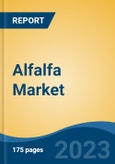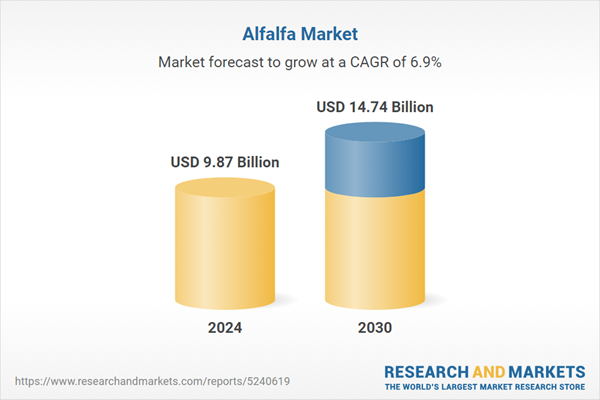Speak directly to the analyst to clarify any post sales queries you may have.
10% Free customizationThis report comes with 10% free customization, enabling you to add data that meets your specific business needs.
Alfalfa hay is rich in energy, protein, fiber, calcium, vitamins, and minerals. The production process involves harvesting the crop using a swather, followed by sun drying in strips. These strips are then mechanically compressed into bales and processed into smaller cubes and pellets. Compared to traditional grass hay, alfalfa hay offers superior nutritional value and palatability. Furthermore, it is used in the production of nutritional supplements that support animal growth and enhance immune function.
The increasing global demand for animal-based products, driven by rising incomes, dietary changes, and population growth, is contributing to a surge in the consumption of meat, eggs, and dairy products. According to the USDA, meat consumption in the U.S. grew by nearly 6% between 2018 and 2023, from 38,113 metric tons to 40,395 metric tons. This growth highlights the rising demand for animal products in everyday diets. As the demand for premium meat products increases, there is a parallel rise in the need for improved nutrition in animal feed, thus driving the global market growth for alfalfa.
Key Market Drivers:
1. Increased Alfalfa Yields through Genetic Modifications: Genetic modifications have the potential to significantly boost alfalfa yields. These modifications introduce traits that make the crop more resilient to pests, diseases, and adverse weather conditions. Enhanced yields enable farmers to produce more alfalfa per unit of land, improving efficiency and reducing costs. This makes alfalfa a more attractive feed option for livestock farmers, as it becomes more cost-effective and reliable.Additionally, higher yields contribute to a smaller land footprint, which is particularly beneficial in regions where arable land is limited. The enhanced availability and reduced costs, along with the known nutritional benefits of alfalfa, are expected to drive increased demand. There is also potential for alfalfa's use in non-traditional industries, such as biofuel production, where its high biomass yield can be leveraged. As a result, the enhanced yield of alfalfa, driven by genetic modifications, could significantly spur global demand.
Key Market Challenges:
2. Impact of Varying Climatic Conditions: Alfalfa, a high-yield crop integral to global agriculture, is highly sensitive to changes in climate. Unpredictable weather patterns and the increasing frequency of extreme weather events can severely affect alfalfa growth. Prolonged droughts can lead to insufficient water supply for irrigation, reducing yields, while excessive rainfall may result in waterlogging and heightened disease risks, diminishing both the quality and quantity of production.Additionally, temperature fluctuations can disrupt alfalfa’s growth cycle, leading to reduced productivity. Global climate change exacerbates these challenges, and as extreme weather events become more common, the feasibility of consistent, large-scale alfalfa production may diminish, leading to decreased global demand. Climate change could also reduce profitability for farmers, who may choose more climate-resilient crops. Consequently, shifting global climate conditions present a significant threat to the demand for alfalfa worldwide.
Key Market Trends:
3. Rising Export and Import Trade of Alfalfa: As global demand for dairy and meat products increases, the trade of alfalfa, a premium forage crop commonly used in animal diets, is set to expand. Countries with favorable growing conditions are ramping up alfalfa production to meet international demand. On the import side, nations with growing dairy and meat industries are seeking high-yield forages to supplement animal feed. For example, Middle Eastern and Asian countries, where conditions for alfalfa cultivation are suboptimal, rely heavily on imports to support their dairy and meat production.Similarly, countries like the United States and Canada, with favorable conditions for alfalfa farming, are enhancing their export capacities to meet this rising demand. The global trade of alfalfa is also driven by increasing awareness of the nutritional value of animal feeds. As countries prioritize high-quality feed to support animal health, demand for premium alfalfa is expected to rise. Overall, the growth in export and import activities, driven by rising global demand for quality dairy and meat products, will likely boost alfalfa demand worldwide.
Key Market Players:
- Alfalfa Monegros SL
- Riverina (Australia) Pty
- Mc Cracken Hay Company
- Cubeit Hay Company
- M&C Hay
- Standlee Hay Company
- Anderson Hay & Grain Inc.
- Haykingdom Inc.
- Al Dahra ACX Global, Inc.
- SL Follen Company
Report Scope: This report segments the Global Alfalfa Market into the following categories, with detailed industry trends:
Alfalfa Market by Product Type:
- Bales
- Pellets
- Cubes
Alfalfa Market by Application:
- Dairy Cow Feed
- Cattle & Sheep Feed
- Pig Feed
- Horse Feed
- Poultry Feed
- Others
Alfalfa Market by Region:
- North America (United States, Canada, Mexico)
- Europe (France, United Kingdom, Italy, Germany, Spain)
- Asia-Pacific (China, India, Japan, Australia, South Korea)
- South America (Brazil, Argentina, Colombia)
- Middle East & Africa (South Africa, Saudi Arabia, UAE)
Available Customizations: TechSci Research offers customizations of this report to cater to specific company requirements. Customization options include:
- Detailed analysis and profiling of additional market players (up to five).
This product will be delivered within 1-3 business days.
Table of Contents
Companies Mentioned
- Alfalfa Monegros SL
- Riverina (Australia) Pty
- Mc Cracken Hay Company
- Cubeit Hay Company
- M&C Hay
- Standlee Hay Company
- Anderson Hay & Grain Inc.
- Haykingdom Inc.
- Al Dahra ACX Global, Inc.
- SL Follen Company
Table Information
| Report Attribute | Details |
|---|---|
| No. of Pages | 185 |
| Published | February 2025 |
| Forecast Period | 2024 - 2030 |
| Estimated Market Value ( USD | $ 9.87 Billion |
| Forecasted Market Value ( USD | $ 14.74 Billion |
| Compound Annual Growth Rate | 6.9% |
| Regions Covered | Global |
| No. of Companies Mentioned | 10 |









